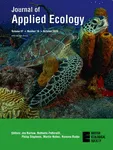BTO create and publish a variety of important articles, papers, journals and other publications, independently and with our partners, for organisations, government and the private sector. Some of our publications (books, guides and atlases) are also available to buy in our online shop.
Annual report of the Seabird Monitoring Programme
Seabird Population Trends and Causes of Change: 1986–2023
This report presents the latest seabird population trends in breeding abundance and productivity using data from the Seabird Monitoring Programme (SMP).
The report documents changes in the abundance and productivity of breeding seabird species in Britain and Ireland from 1986 to 2023, and provides a detailed account of the 2021, 2022 and 2023 breeding seasons.

Search settings
Roads as a contributor to landscape-scale variation in bird communities
Author: Cooke, S.C., Balmford, A., Donald, P.F., Newson, S.E. & Johnston, A.
Published: 2020
07.07.20
Papers
Breeding bird communities within a parkland-woodland continuum: the distinctiveness of wood-pasture
Author: Fuller, R.J. & Green, T.
Published: 2020
12.06.20
Papers
Audit of local studies of breeding Curlew and other waders in Britain and Ireland
Author: Wilson, M., Calladine, J. & Wernham, C.
Published: 2020
09.06.20
Reports
Livestock grazing impacts components of the breeding productivity of a common upland insectivorous passerine: Results from a long‐term experiment
Author: Malm, L.E., Pearce‐Higgins, J.W., Littlewood, N.A., Karley, A.J., Karaszewska, E., Jaques, R., Pakeman, R.J., Redpath, S.M. & Evans, D.M.
Published: 2020
01.06.20
Papers
Evaluating the potential for bird‐habitat models to support biodiversity‐friendly urban planning
Author: Plummer, K.E., Gillings, S. & Siriwardena, G.M.
Published: 2020
This BTO study modelled the abundance of breeding birds within built-up areas, exploring how this varied in relation to the characteristics of these urban environments. It highlighted the potential of an evidence-based – and spatially explicit – evaluation of urban development impacts on biodiversity, by predicting the consequences for bird numbers.
01.06.20
Papers
